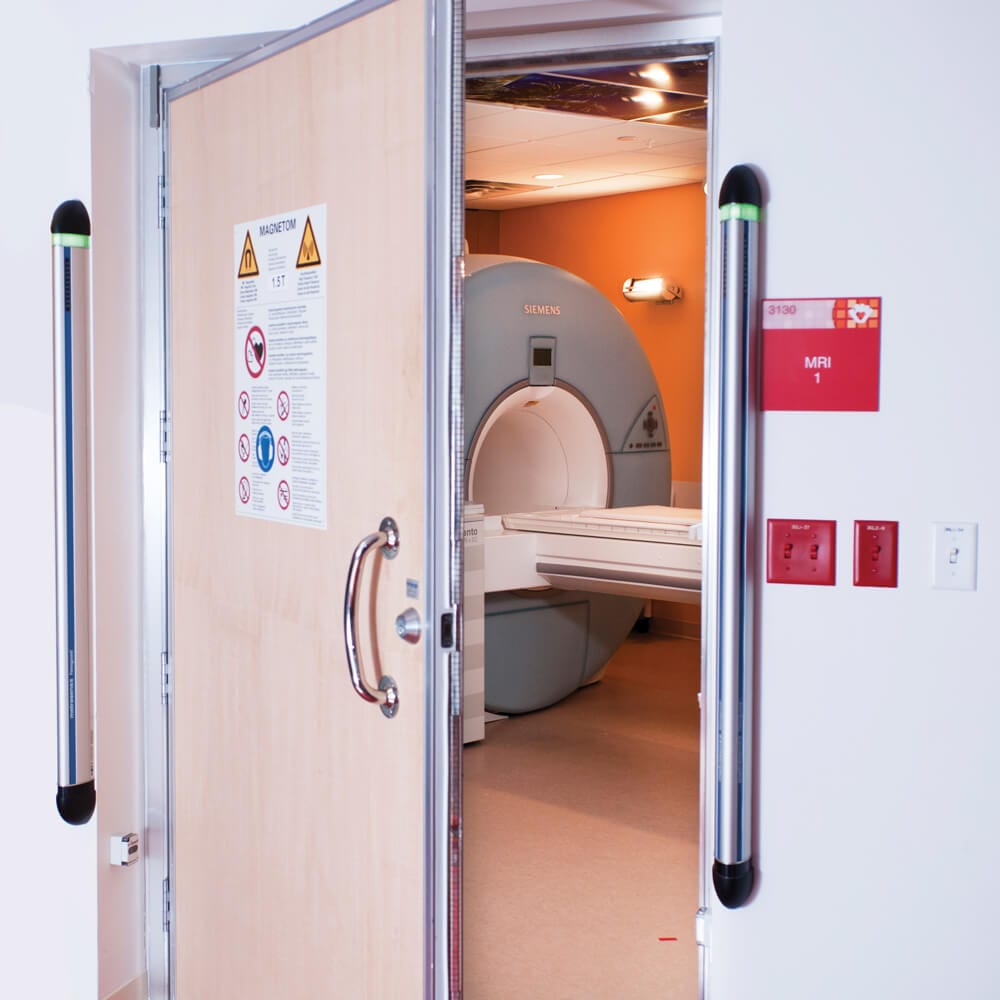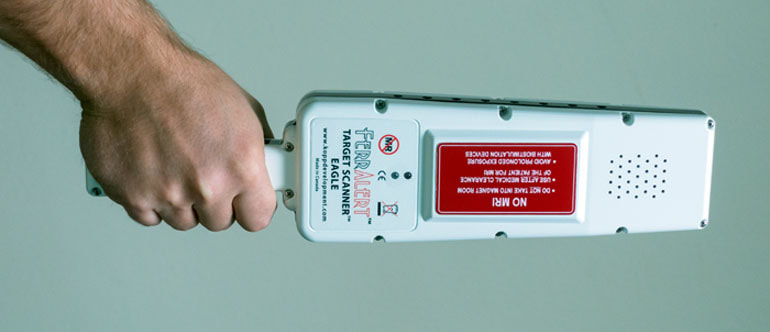The American College of Radiology (ACR) and VA Health Care recommend, while The Joint Commission (TJC) and Facilities Guideline Institute (FGI) require, that all new and renovated MRI suites be equipped with Ferromagnetic Detection Systems (FMDS). Unlike airport security devices that “alarm” on all metals, FMDS detect only ferromagnetic objects (i.e., those that could potentially become projectiles in a strong magnetic field).
Both stationary and hand-held FMDS are available. Stationary devices, also known as pillar detectors, are typically mounted on either side of the doorway to the MR scanner. When someone walks through (or is pushed through on a stretcher) the FMDS senses if the ambient magnetic field has been disturbed by a ferromagnetic object. FMDS can also be used in ACR Area II as an adjunct to initial patient screening. If the ferromagnetic object cannot be immediately located, a hand-held device can then be used to find it.
|
FMDS are designed primarily to detect ferromagnetic objects outside the patient and do so with very high sensitivity and specificity. They may also be used to detect internal ferromagnetic objects, though their reliability in this regard is still under investigation.
|
Notwithstanding the enthusiasm of many authorities, I am not at all a big proponent of these devices. I always worried that technologists might become overly dependent on them and not do as careful a job screening patients personally. Additionally, a non-trivial number false alarms occur (though the newest models claim to be more accurate). Some of the alarms are true-positives, but "extraneous", such as when a technologist walks through the portal wearing ferromagnetic materials, such as shoe tangs, dental braces, bra clasps, or underwires. Some fully MR compatible devices containing a few tiny internal ferromagnetic parts will set off the alarms although they are safe to use. The end result can be "alarm fatigue" where technologists subconsciously fail to hear or heed the beeps.
Finally the fact that these devices detect only ferromagnetic materials is also a disadvantage. They will not detect non-ferromagnetic metals (like copper or aluminum) that may be present in EKG leads, piercings, and drug patches -- all of which can be associated with electrical burns and which must be identified prior to MR imaging. In truth, burns are a far more common problem than projectile injuries, which are distinctly rare.
Advanced Discussion (show/hide)»
No supplementary material yet. Check back soon!
References
Bucci R, Ferguson R, Frank H. MRI ferromagnetic detector system: fatigue study. Radiology Management Nov/Dec 2016:27-30. (describes alarm fatigue)
Delfino JG, Krainak DM, Flesher SA. MRI-related FDA adverse events reports: a 10-yr review. Med Phys 2019; 46:5562-5571. [DOI LInk] (summary of 906 injuries from 2008-2017 showing that nearly all significant projectile events were of large objects such as wheelchairs, walkers, IV poles, gas cylinders rather than tiny hidden objects like earrings or hairpins)
Orchard LJ. Implementation of a ferromagnetic detection system in a clinical MRI setting. Radiography 2015; 21:248-253. [DOI Link]
Shellock FG, Karacozoff AM. Detection of implants and other objects using a ferromagnetic detection system: implications for patient screening before MRI. AJR Am J Radiol 2013; 201:720-725. [DOI Link]
Bucci R, Ferguson R, Frank H. MRI ferromagnetic detector system: fatigue study. Radiology Management Nov/Dec 2016:27-30. (describes alarm fatigue)
Delfino JG, Krainak DM, Flesher SA. MRI-related FDA adverse events reports: a 10-yr review. Med Phys 2019; 46:5562-5571. [DOI LInk] (summary of 906 injuries from 2008-2017 showing that nearly all significant projectile events were of large objects such as wheelchairs, walkers, IV poles, gas cylinders rather than tiny hidden objects like earrings or hairpins)
Orchard LJ. Implementation of a ferromagnetic detection system in a clinical MRI setting. Radiography 2015; 21:248-253. [DOI Link]
Shellock FG, Karacozoff AM. Detection of implants and other objects using a ferromagnetic detection system: implications for patient screening before MRI. AJR Am J Radiol 2013; 201:720-725. [DOI Link]
Related Questions
Have you ever had a significant ferromagnetic projectile event or injury at your MR site?
Which types of metal are the most dangerous around a magnetic field?
How do you screen patients for implants and foreign bodies prior to MRI?
Have you ever had a significant ferromagnetic projectile event or injury at your MR site?
Which types of metal are the most dangerous around a magnetic field?
How do you screen patients for implants and foreign bodies prior to MRI?


